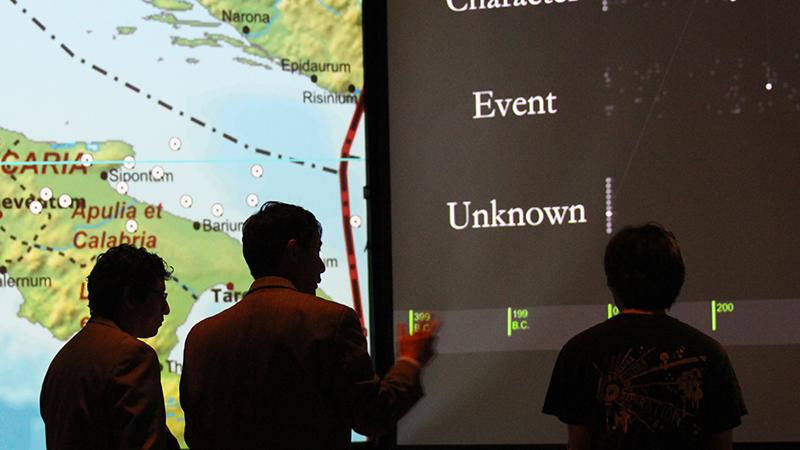August 19, 2016

An interactive conference room tracks the conversation of meeting participants, aiding the proceedings with additional information and data in real-time. A computer interface in the shape of a cylindrical fire pit allows users to discuss data projected onto its interior. Narrative abilities make it possible for users to explore complex scenarios – like the links between disparate events and characters in world history, or learning a new language – and make sense of data rich subjects. Each of these three research projects is under development within the Curtis R. Priem Experimental Media and Performing Arts Center (EMPAC) at Rensselaer Polytechnic Institute, which was the stage for the institute’s third annual research showcase held Thursday.
“The research enterprise at Rensselaer is addressing problems of substance – making discoveries and translating the things that we discover into applications that will impact society not only today but in the decades to come,” said Jonathan Dordick, vice president of the Office of Research. “Our work is rooted in basic research, with science that seeks to understand the origins of life and matter, and reaches all the way through to commercial development.”
Research at Rensselaer fulfills the vision of The New Polytechnic, an emerging paradigm for higher education which recognizes that global challenges and opportunities are so great they cannot be adequately addressed by even the most talented person working alone. Rensselaer serves as a crossroads for collaboration—working with partners across disciplines, sectors, and geographic regions—to address complex global challenges, using the most advanced tools and technologies, many of which are developed at Rensselaer. Research at Rensselaer addresses some of the world’s most pressing technological challenges—from energy security and sustainable development to biotechnology and human health. The New Polytechnic is transformative in the global impact of research, in its innovative pedagogy, and in the lives of students at Rensselaer.
“The showcase is an opportunity for community stakeholders to experience first-hand the research that shapes the innovation economy both within the Capital Region and on a global scale,” said Richie Hunter, vice president of Strategic Communications and External Relations, which hosted the event.
“Like the problems that face us, the solutions will be complex and interdependent and based on deep scientific understanding and cutting-edge technology,” said Hunter. “With the help of funding from federal government agencies, New York State, industry, and private foundations, we are generating knowledge and solutions, and that's evident in the body of research on display at this event.”
Rensselaer presented research that leverages EMPAC facilities, which were designed to make it possible to experience digital information at the human scale. Much of the current research within EMPAC stems from the activities of the Cognitive and Immersive Systems Laboratory (CISL), a partnership between Rensselaer and IBM Research, founded in 2015 to pioneer new frontiers in the scientific field of immersive cognitive systems.
CISL’s mission is to explore and advance natural, collaborative problem-solving among groups of humans and machines. The lab is built around a futuristic “Situations Room” that can be adapted to industry-specific environments (including Cognitive Boardrooms, Design Studios, Diagnosis Rooms, and Immersive Classrooms) and is designed to surface new ways to improve how people work together. The research projects on display during the showcase each contribute to that mission.
During the event, Hui Su, CISL director, demonstrated a newly established link between a studio within EMPAC and IBM’s Watson cognitive computing system. With the link, CISL will begin experimenting with various enhancements to the interface between users and Watson, such as tracking users, including facial and gestural recognition, in EMPAC Studio 2.
Jonas Braasch, an associate professor and director of the Center for Cognition, Communication, and Culture, which works with CISL, reviewed how advances in computer vision will enable smart environments to understand the activities of occupants in real-time situations like conference rooms, large classrooms, and airport concourses.
Ben Chang, head of the Games and Simulations Arts and Sciences program, discussed how advances in computer-aided interactive narratives can support the humanities, making it possible for students to choose their own path through the study of world history, for example, or creating compelling scenarios that accelerate language learning.
The 2015 showcase highlighted research within the Center for Biotechnology and Interdisciplinary Studies, while the 2014 showcase focused on research at the Rensselaer Tech Park, including the Rensselaer Aquatic Laboratory, the Center for Computational Innovations, and the Collaborative-Research Augmented Immersive Virtual Environment Lab.